Basquiat: Boom for Real, Barbican review - the myth explored | reviews, news & interviews
Basquiat: Boom for Real, Barbican review - the myth explored
Basquiat: Boom for Real, Barbican review - the myth explored
Appraising the graffiti artist whose paintings fetch over $100 million at auction
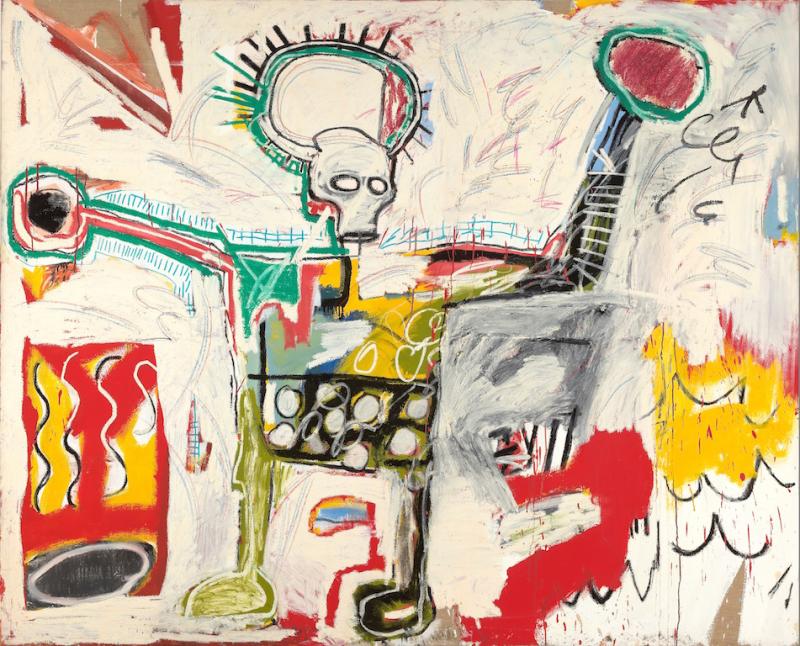
Beautiful, shy, charming and talented, Jean-Michel Basquiat was a shining star who streaked across the New York skyline for a few brief years in the early 1980s before a heroin overdose claimed his life at the age of only 27.
I’ve introduced him as a phenomenon rather than an artist, because that’s how the Barbican exhibition presents him. The upstairs space charts his meteoric rise to fame from the graffiti writer, SAMO © (same old shit) to the painter whose 1982 canvas of a skull fetched over $110 million at Sotheby’s last May. The highest price ever paid at auction for an American artwork, it put Basquiat in the same league as Francis Bacon and Picasso.
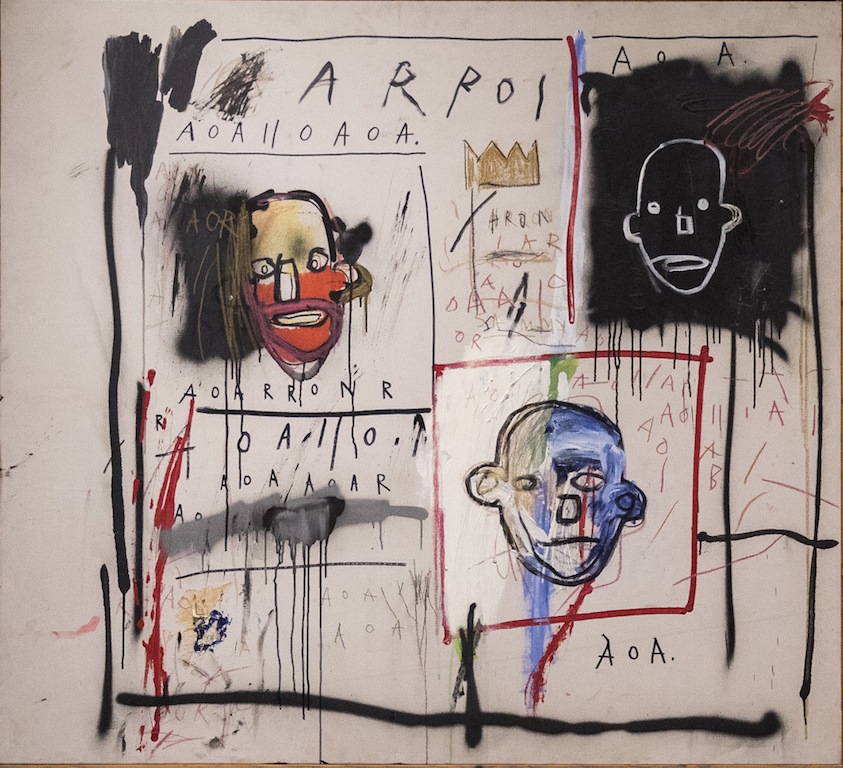 This fascinating trawl through the downtown scene in the late 1970s and early ‘80s takes you to SOHO where, having dropped out of high school, Basquiat began spray-painting comments like “SAMO © as a neo artform”, "SAMO © for the quasi avant garde” and “SAMO © as an alternative to blah blah, quasi blah”. Sprayed in neat capitals across gallery doors and outside walls, these savvy remarks fuelled intense curiosity about the identity of the writer.
This fascinating trawl through the downtown scene in the late 1970s and early ‘80s takes you to SOHO where, having dropped out of high school, Basquiat began spray-painting comments like “SAMO © as a neo artform”, "SAMO © for the quasi avant garde” and “SAMO © as an alternative to blah blah, quasi blah”. Sprayed in neat capitals across gallery doors and outside walls, these savvy remarks fuelled intense curiosity about the identity of the writer.
Along with other aspiring artists, musicians, poets and performers, Basquiat frequented the Mudd Club, where he played with his band Gray. There he met Glenn O’Brien, music critic for Interview magazine, who cast him in the film Downtown 81 as a struggling artists trying to make his way in the New York art world. In effect, Basquiat was playing himself. Having been outed as SAMO © in 1979, he had stopped tagging and begun making postcards with Jennifer Stein, which they touted outside the Museum of Modern Art for $1 a piece. They even sold a card of sunglasses to Warhol, with whom Basquiat would collaborate a few years later.
His big break came in 1981, when he was included in New York/New Wave, a sprawling group show of over 100 artists curated for the gallery PS1 by Diego Cortez, co-founder of the Mudd Club. Cortez juxtaposed stars such as Andy Warhol, William Burroughs, Nan Goldin and Robert Mapplethorpe with graffiti artists like Keith Haring, Futura 2000 and Lee Quinones. Fifteen of the paintings shown by Basquiat are reunited here (pictured above right: Untitled 1981 © Tristan Fewings/Getty Images). It's hard to see why these naive outline drawings of cars, planes, buildings, faces and figures attracted so much attention, but this positive response prompted Basquiat to go home and announce to his father, “Papa, I’ve made it!”
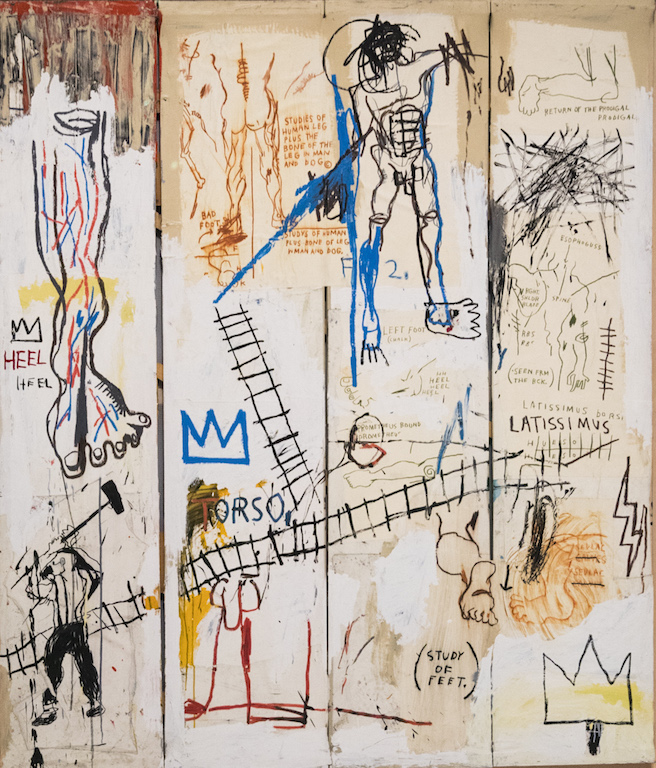 He never looked back. Later that year, his friend Rene Ricard wrote an article about him for the influential journal Artforum titled “The Radiant Child” and the New York art scene embraced as an exotic outsider the disarming young man, whose charm and diffidence belied the fierce energy fuelling his wayward pictures.
He never looked back. Later that year, his friend Rene Ricard wrote an article about him for the influential journal Artforum titled “The Radiant Child” and the New York art scene embraced as an exotic outsider the disarming young man, whose charm and diffidence belied the fierce energy fuelling his wayward pictures.
As though to compensate for treating him primarily as a phenomenon, on the lower floor the Barbican presents Basquiat’s paintings thematically and analyses them to bits. “I never went to art school, I just looked,” he once said. His mother nurtured her young son’s talent and interest by taking him to museums and galleries and gave him a copy of Gray’s Anatomy. Anatomical drawing remained an ongoing preoccupation and in Leonardo’s Greatest Hits, 1982, (pictured above left) he translates a page of drawings from Leonardo’s sketchbooks into their fierce, cartoon-like equivalents.
Surrounding himself with books on art, music and everything else besides, Basquiat remained a voracious consumer of images and information. In a clip from Warhol’s TV show he remarks that his paintings are about everything. “I get my facts,” he said, “from books, stuff on atomisers, the blues, ethyl alcohol, geese in Egyptian 'glyphs.” In pictures that are like stream-of-consciousness depictions of his current preoccupations, he obsessively lists things from car brands to metals, animals, the elements and the names of people he admired (pictured below right: Untitled Pablo Picasso 1984)
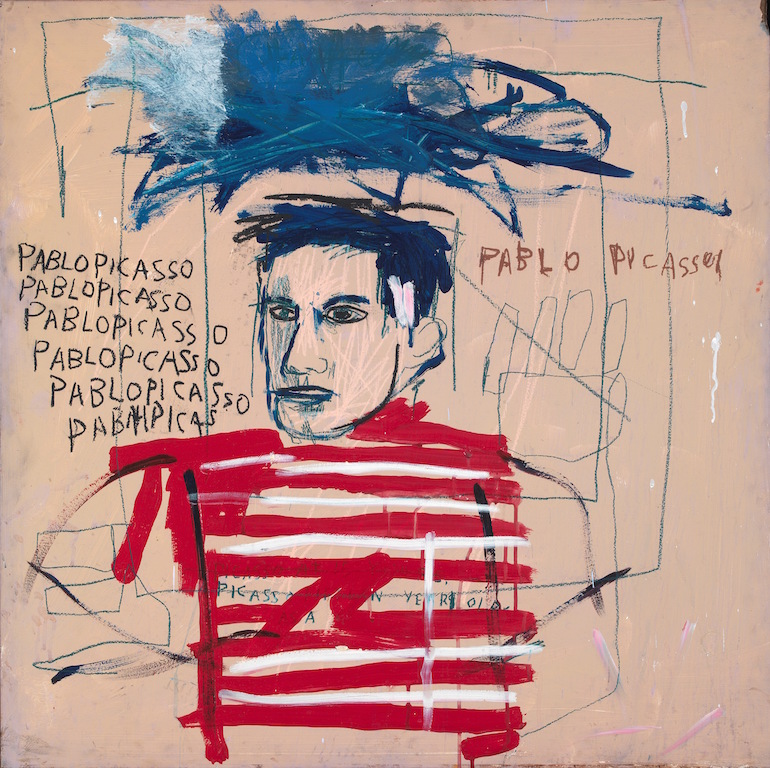 His interests were eclectic, but far from random. His love of jazz and bepop (he owned 3,000 records) translates into eulogies for black musicians such as Louis Armstrong, Charlie Parker and Dizzy Gillespie based on images sampled from his collection of books. He consistently features black achievers, from world heavyweight champion Jack Johnson to athlete Jesse Owens who challenged Hitler’s belief in white supremacy by winning a gold medal at the 1936 Olympics. The vexed issue of slavery is cited with reference to the sugar and cotton trades, while portraits of Charles Darwin and TH Huxley were inspired by their belief that homo sapiens originated in Africa. Nothing is ever spelled out; words and images riff off each other in multi-layered conversations that are a gift to art historians who can beaver away to uncover the multiple sources from which the artist drew his material.
His interests were eclectic, but far from random. His love of jazz and bepop (he owned 3,000 records) translates into eulogies for black musicians such as Louis Armstrong, Charlie Parker and Dizzy Gillespie based on images sampled from his collection of books. He consistently features black achievers, from world heavyweight champion Jack Johnson to athlete Jesse Owens who challenged Hitler’s belief in white supremacy by winning a gold medal at the 1936 Olympics. The vexed issue of slavery is cited with reference to the sugar and cotton trades, while portraits of Charles Darwin and TH Huxley were inspired by their belief that homo sapiens originated in Africa. Nothing is ever spelled out; words and images riff off each other in multi-layered conversations that are a gift to art historians who can beaver away to uncover the multiple sources from which the artist drew his material.
By exploring black history, its as though Basquiat was searching for confirmation of his own identity for, despite his burgeoning success, he clearly felt like an outsider in the predominantly white art world. When, in 1983, he was invited to Los Angeles for his second show at the prestigious Larry Gagosian Gallery, he was joined by graffiti artists Rammellzee and Toxic. Hollywood Africans features the three friends looking perplexed in tinseltown, where racial stereotypes are routinely reinforced by movies featuring blacks as maids, servants, criminals and thugs. In an interview Basquiat remarked that he would like to be a film director making movies about Afro-Americans as “people of the human race and not aliens, and not all thieves and drug dealers”.
He usually portrayed himself as a mask-like black face crowned with spiky dreadlocks, while the leering skulls that frequent his paintings are a vibrant mix between African masks and cartoon monsters (pictured below: Glenn, 1984). In a self-portrait of 1982 (main picture), painted for his first solo show, he looks like a strange cross between a voodoo god, Jesus Christ crowned with thorns and a boxing champion, his raised arms suggesting both crucifixion and a victory salute. While the wild flurry of bright scribbles and patterns surrounding him suggest the intoxication of success, the underlying implication of martyrdom is sadly prescient.
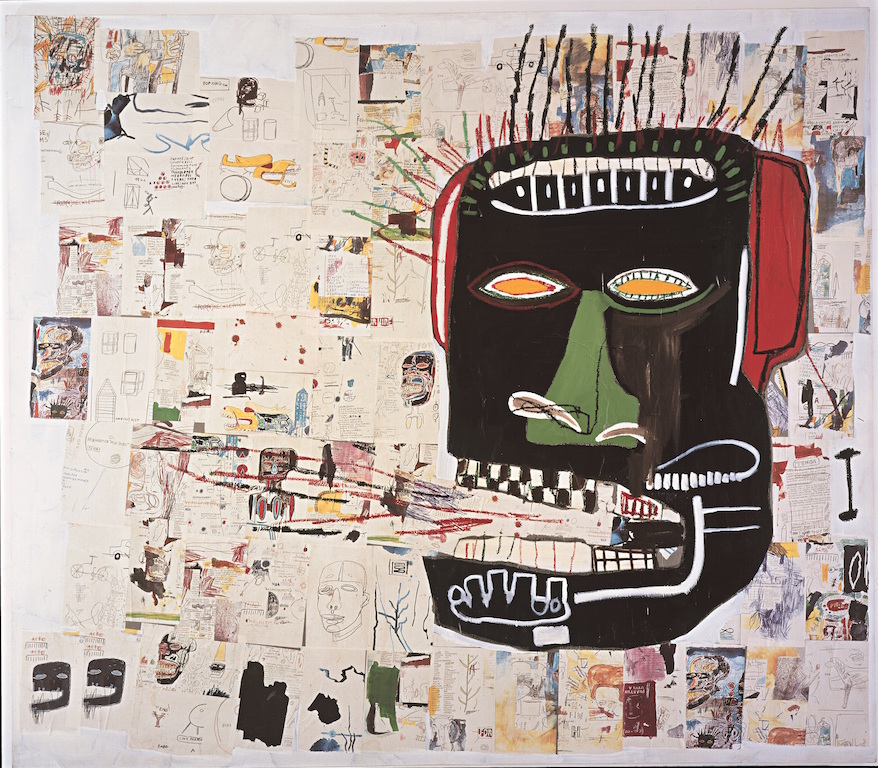 He didn’t really have a chance. Embraced as a protégé by Warhol, with whom he collaborated for over a year, and gobbled up by international acclaim, Basquiat took refuge in the drugs that brought his life to an abrupt end, but kickstarted an inexorable rise to posthumous fame. While its impossible to separate the man from the myth, this exhibition encourages the elision. This makes for a fascinating experience, but does Basquiat no favours as an artist since it directs one’s reading of the pictures too narrowly. We’ll probably have to wait several more decades for the myth to fade and the work to shine with its own light.
He didn’t really have a chance. Embraced as a protégé by Warhol, with whom he collaborated for over a year, and gobbled up by international acclaim, Basquiat took refuge in the drugs that brought his life to an abrupt end, but kickstarted an inexorable rise to posthumous fame. While its impossible to separate the man from the myth, this exhibition encourages the elision. This makes for a fascinating experience, but does Basquiat no favours as an artist since it directs one’s reading of the pictures too narrowly. We’ll probably have to wait several more decades for the myth to fade and the work to shine with its own light.
- Basquiat: Boom for Real at the Barbican to 28 January 2018
- More visual art reviews on theartsdesk
rating
Explore topics
Share this article
Add comment
The future of Arts Journalism
You can stop theartsdesk.com closing!
We urgently need financing to survive. Our fundraising drive has thus far raised £49,000 but we need to reach £100,000 or we will be forced to close. Please contribute here: https://gofund.me/c3f6033d
And if you can forward this information to anyone who might assist, we’d be grateful.

Subscribe to theartsdesk.com
Thank you for continuing to read our work on theartsdesk.com. For unlimited access to every article in its entirety, including our archive of more than 15,000 pieces, we're asking for £5 per month or £40 per year. We feel it's a very good deal, and hope you do too.
To take a subscription now simply click here.
And if you're looking for that extra gift for a friend or family member, why not treat them to a theartsdesk.com gift subscription?
more Visual arts
 'We are bowled over!' Thank you for your messages of love and support
Much-appreciated words of commendation from readers and the cultural community
'We are bowled over!' Thank you for your messages of love and support
Much-appreciated words of commendation from readers and the cultural community
![SEX MONEY RACE RELIGION [2016] by Gilbert and George. Installation shot of Gilbert & George 21ST CENTURY PICTURES Hayward Gallery](https://theartsdesk.com/sites/default/files/styles/thumbnail/public/mastimages/Gilbert%20%26%20George_%2021ST%20CENTURY%20PICTURES.%20SEX%20MONEY%20RACE%20RELIGION%20%5B2016%5D.%20Photo_%20Mark%20Blower.%20Courtesy%20of%20the%20Gilbert%20%26%20George%20and%20the%20Hayward%20Gallery._0.jpg?itok=7tVsLyR-) Gilbert & George, 21st Century Pictures, Hayward Gallery review - brash, bright and not so beautiful
The couple's coloured photomontages shout louder than ever, causing sensory overload
Gilbert & George, 21st Century Pictures, Hayward Gallery review - brash, bright and not so beautiful
The couple's coloured photomontages shout louder than ever, causing sensory overload
 Lee Miller, Tate Britain review - an extraordinary career that remains an enigma
Fashion photographer, artist or war reporter; will the real Lee Miller please step forward?
Lee Miller, Tate Britain review - an extraordinary career that remains an enigma
Fashion photographer, artist or war reporter; will the real Lee Miller please step forward?
 Kerry James Marshall: The Histories, Royal Academy review - a triumphant celebration of blackness
Room after room of glorious paintings
Kerry James Marshall: The Histories, Royal Academy review - a triumphant celebration of blackness
Room after room of glorious paintings
 Folkestone Triennial 2025 - landscape, seascape, art lovers' escape
Locally rooted festival brings home many but not all global concerns
Folkestone Triennial 2025 - landscape, seascape, art lovers' escape
Locally rooted festival brings home many but not all global concerns
 Sir Brian Clarke (1953-2025) - a personal tribute
Remembering an artist with a gift for the transcendent
Sir Brian Clarke (1953-2025) - a personal tribute
Remembering an artist with a gift for the transcendent
 Emily Kam Kngwarray, Tate Modern review - glimpses of another world
Pictures that are an affirmation of belonging
Emily Kam Kngwarray, Tate Modern review - glimpses of another world
Pictures that are an affirmation of belonging
 Kiefer / Van Gogh, Royal Academy review - a pairing of opposites
Small scale intensity meets large scale melodrama
Kiefer / Van Gogh, Royal Academy review - a pairing of opposites
Small scale intensity meets large scale melodrama
 Jenny Saville: The Anatomy of Painting, National Portrait Gallery review - a protégé losing her way
A brilliant painter in search of a worthwhile subject
Jenny Saville: The Anatomy of Painting, National Portrait Gallery review - a protégé losing her way
A brilliant painter in search of a worthwhile subject
 Abstract Erotic, Courtauld Gallery review - sculpture that is sensuous, funny and subversive
Testing the boundaries of good taste, and winning
Abstract Erotic, Courtauld Gallery review - sculpture that is sensuous, funny and subversive
Testing the boundaries of good taste, and winning
 Edward Burra, Tate Britain review - watercolour made mainstream
Social satire with a nasty bite
Edward Burra, Tate Britain review - watercolour made mainstream
Social satire with a nasty bite
 Ithell Colquhoun, Tate Britain review - revelations of a weird and wonderful world
Emanations from the unconscious
Ithell Colquhoun, Tate Britain review - revelations of a weird and wonderful world
Emanations from the unconscious

Comments
Perhaps I am missing
I haven't seen the exhibition
A disappointing and badly